According to a new study to be published in a forthcoming issue of the Journal of Vascular Surgery (JVS), only 42 percent of new lower-limb amputees are referred to a prosthetist by their surgical care team or primary care physician.
That’s a shockingly low number, given that prosthesis use correlates strongly with post-amputation health. In essence, 58 percent of the amputees in this study were consigned to a higher-risk category by not getting referred to a prosthetist. Neither high costs nor porous insurance explained the lack of referrals. The investigation focused on a simple initial consultation with a prosthetist, which often costs nothing and almost never costs a prohibitive amount.

So if cost wasn’t the issue, what prevented these patients from getting the care necessary to achieve good health after limb loss? The researchers found that new amputees with certain characteristics were far less likely than average to get referred to a prosthetic clinic. For example, patients with life-threatening health issues such as kidney impairment, intestinal obstructions, or heart problems were rarely referred. As the JVS authors acknowledge, such underlying health conditions might make it ill-advised, or even impossible, for a patient to get fitted for a limb.
Other patients who were referred at below-average rates included women, smokers, people with diabetes, and individuals above the age of 70. Unfortunately, there are no standardized criteria for referral, so it’s impossible to know whether non-referred patients are truly unsuitable for prosthetic fitting in a clinical sense. Some of them might legitimately be best served by crutches, wheelchairs, or other mobility aids. But the suspicion is that many amputees are not referred to a prosthetist because of unconscious biases, geographic factors, flaws in the healthcare model, or other criteria that have nothing to do with the individual patient and everything to do with the system that’s supposed to serve them.
“The risk factors for prosthetics referral following amputation have not been adequately investigated,” the study concludes. In calling for deeper study of this issue, the authors emphasize that—even after controlling for other risk factors—patients who are referred to a prosthetist have far better post-amputation outcomes than those who are not. Based on that evidence alone, the 42 percent rate of post-amputation referral to prosthetists is unacceptably low.



